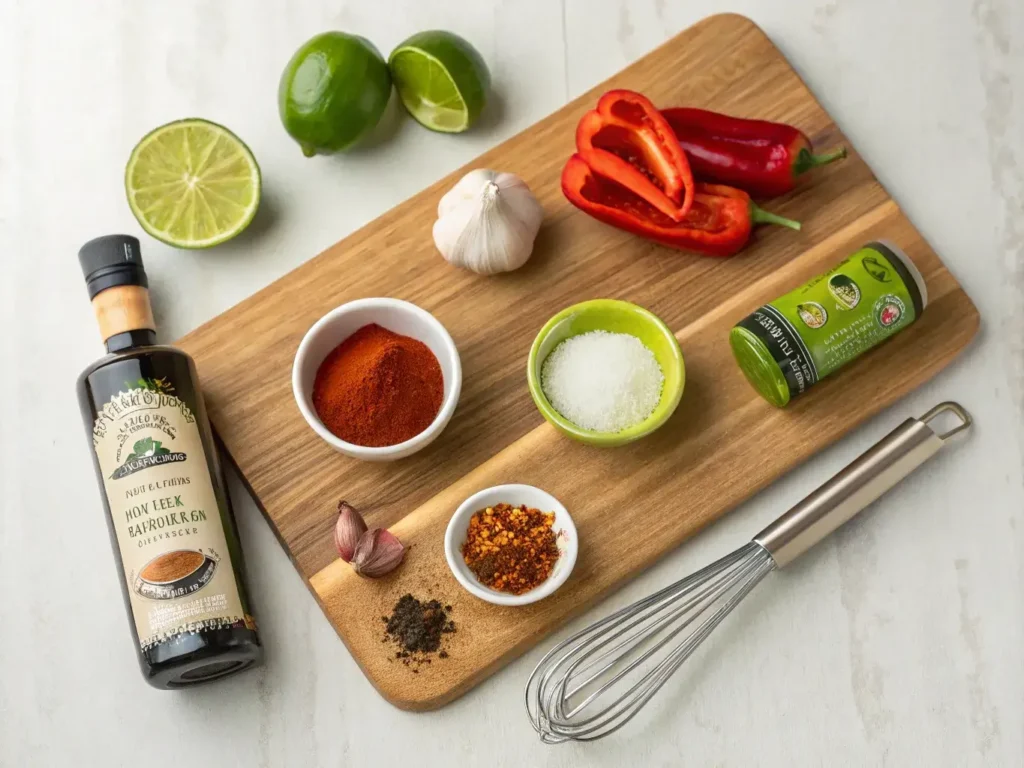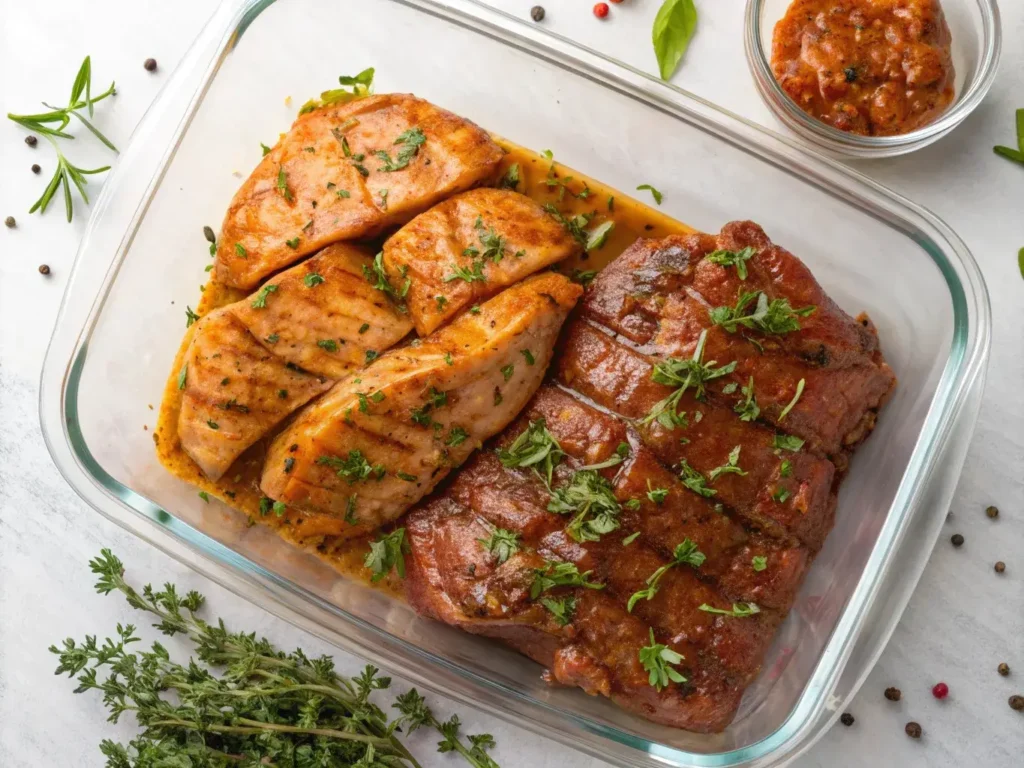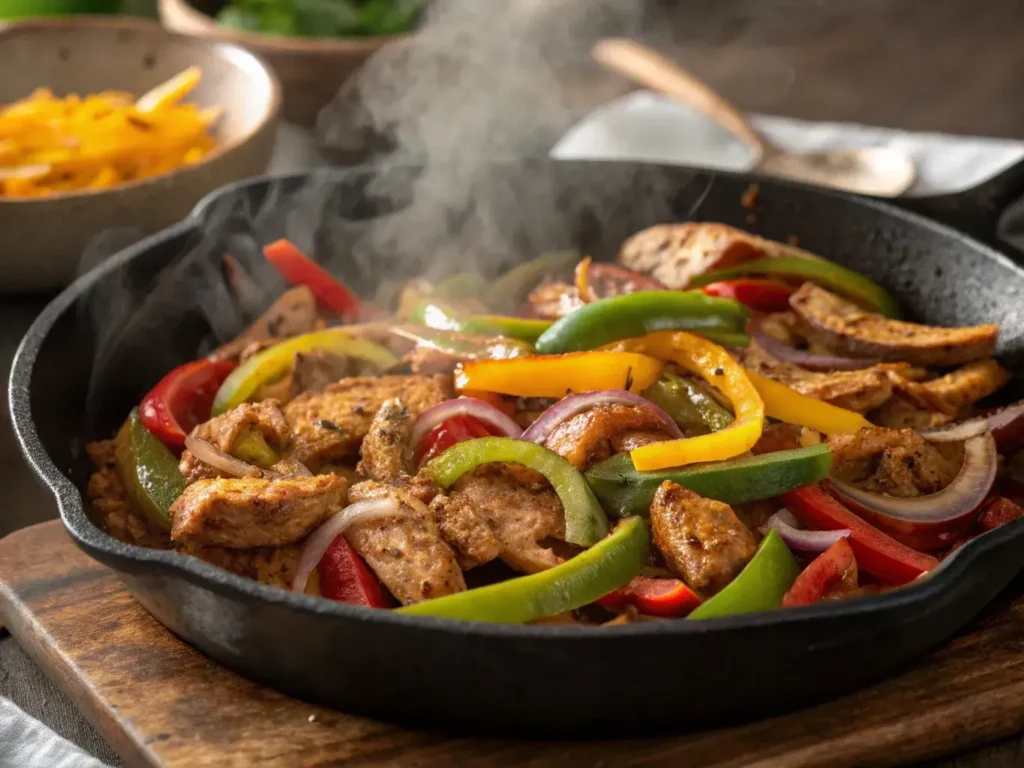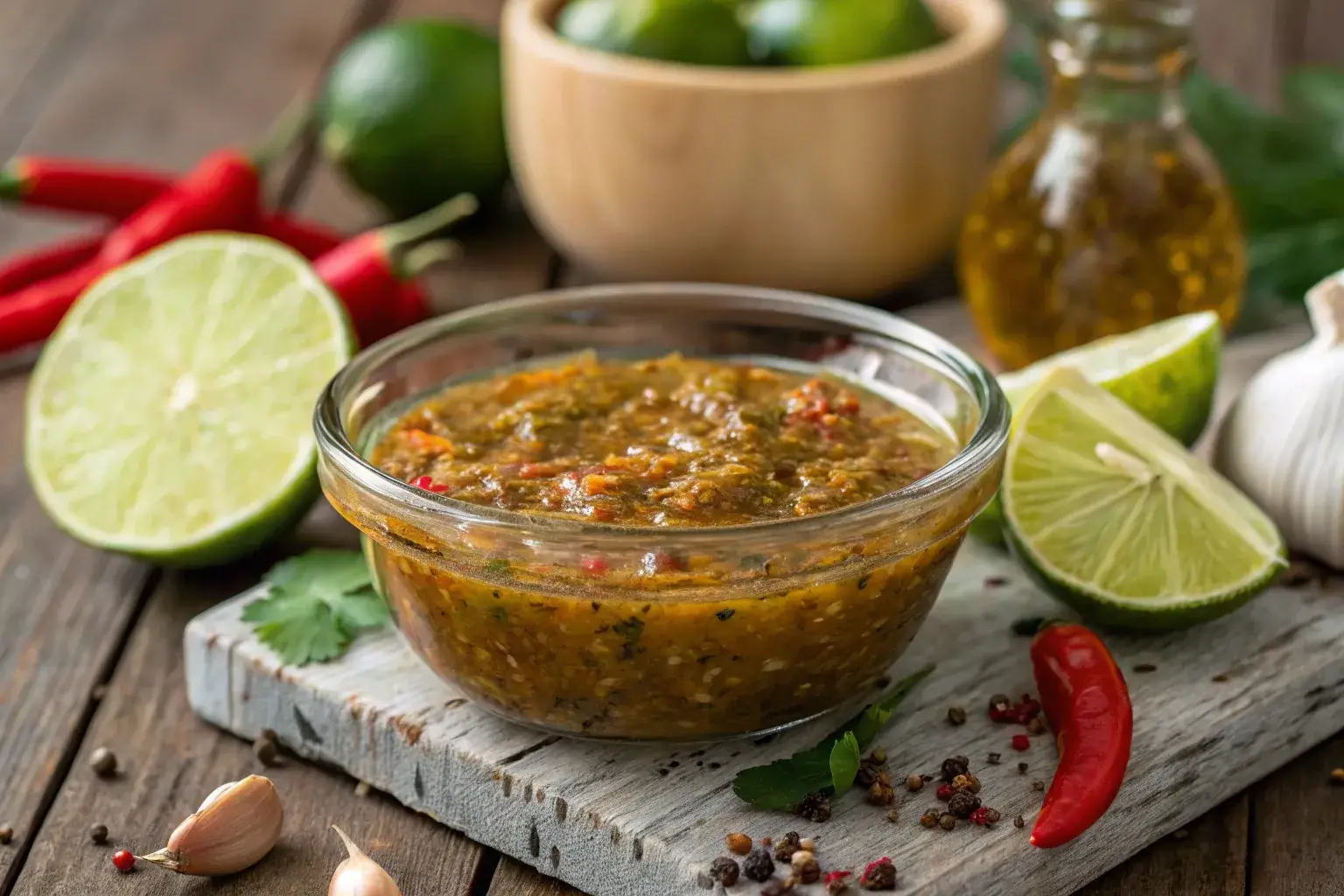Let’s be honest: the secret to unforgettable fajitas isn’t in the sizzle—it’s in the fajita marinade. That tangy, smoky blend of spices transforms ordinary ingredients into a mouthwatering Tex-Mex masterpiece. If you’ve ever wondered how restaurants get their fajitas so juicy and flavorful, here’s the good news: you can do it too! All it takes is a few pantry staples, a splash of lime juice, and five quick minutes. Whether you’re grilling steak, searing chicken, or tossing veggies, this marinade guarantees bold flavors with minimal effort. So, grab your whisk, and let’s dive into the world of homemade fajita marinade magic!
What Is a Fajita Marinade?
Understanding the Basics of Marinades
A fajita marinade is more than just a seasoning mix; it’s the key to unlocking bold, authentic Tex-Mex flavors. Marinades combine three essential components: acid, oil, and seasonings. The acid, like lime juice or vinegar, tenderizes the protein, breaking down fibers for a juicy bite. Oils, such as olive or avocado oil, ensure the seasonings coat evenly, while locking in moisture during cooking. Finally, spices like chili powder, cumin, and paprika create the signature smoky and zesty flavor we all love in fajitas.
Marinades aren’t limited to just meat. In fact, they work wonders on vegetables too! Bell peppers, onions, and even zucchini soak up the flavors beautifully, making this a versatile solution for meat-lovers and vegetarians alike. With a simple fajita marinade, you can elevate any dish from bland to brilliant in just a few minutes.
Why Use a Marinade for Fajitas?
The magic of a fajita marinade lies in its ability to transform basic ingredients into a flavorful Tex-Mex feast. By marinating proteins like chicken, beef, or shrimp, you allow the flavors to penetrate deep into the meat. This creates not only a delicious crust when grilled but also ensures the meat remains tender and juicy.
In addition, marinades help enhance texture. For example, lime juice gently breaks down the fibers in steak, making it easier to chew and enjoy. For veggies, the oil and spices prevent drying out during cooking, while adding a delightful smoky char. Moreover, using a marinade can save time when meal-prepping since everything is seasoned and ready to cook.
It’s no wonder that a well-made fajita marinade is a staple in Tex-Mex cuisine. The combination of practicality and flavor makes it an essential step in creating restaurant-quality fajitas at home.
Types of Proteins and Veggies That Work Best
A great fajita marinade works wonders on a variety of proteins and vegetables. Here’s a quick guide to help you choose the best ingredients for your dish:
- Chicken: Boneless, skinless chicken breasts or thighs are excellent options. They absorb marinades quickly and cook evenly.
- Beef: Flank steak and skirt steak are traditional choices. Their bold flavors pair perfectly with smoky spices and citrusy acids.
- Shrimp: These cook fast and require only 15–30 minutes to marinate, making them perfect for quick meals.
- Vegetables: Bell peppers, onions, zucchini, and mushrooms are fantastic choices. They caramelize beautifully when grilled, soaking up every drop of the marinade.
For inspiration on fajita-friendly ingredients, check out this helpful guide on vegetable grilling from The Spruce Eats. It offers excellent tips for achieving the perfect texture and flavor for your veggies.
The Tex-Mex Origins of Fajita Marinades
The origins of the fajita marinade trace back to the vibrant Tex-Mex cuisine of the Southwestern United States. Fajitas themselves were traditionally made with skirt steak, a tough cut of meat that required tenderizing. Early cooks discovered that soaking the meat in acidic blends like lime juice and vinegar made it not only tender but incredibly flavorful.
Over time, this technique expanded to include a variety of proteins and vegetables, creating the customizable fajitas we enjoy today. What makes Tex-Mex marinades unique is their balance of bold spices, tangy citrus, and subtle sweetness each ingredient working harmoniously to enhance the dish. This history underscores the importance of a well-crafted fajita marinade, as it remains the heart of this beloved culinary tradition.
Essential Ingredients for a Fajita Marinade
The Core Elements of a Perfect Fajita Marinade

At the heart of every delicious fajita marinade is a simple yet powerful combination of ingredients. These core components acid, oil, and spices work together to tenderize, flavor, and seal in moisture. Acidic elements like lime juice or vinegar help break down proteins, making meats like steak or chicken tender and juicy. Oils, such as olive or avocado oil, coat the ingredients evenly while preventing them from drying out during cooking.
Spices and aromatics, however, are what truly define a fajita marinade. Staples like garlic, chili powder, cumin, and paprika provide the bold, smoky Tex-Mex flavor that makes fajitas irresistible. A pinch of cayenne or a splash of soy sauce can also be added for a unique twist. Whether you’re cooking chicken, beef, or vegetables, these ingredients form the foundation of an unforgettable marinade.
Choosing the Right Spices
The spices you choose for your fajita marinade can make or break your dish. Traditional Tex-Mex spices like cumin, chili powder, and smoked paprika are essential for creating that signature smoky heat. Fresh garlic and onion powder enhance the savory notes, while a dash of oregano adds an earthy balance.
For an extra burst of flavor, consider adding chipotle powder or even a touch of adobo sauce. These ingredients provide a smoky depth that pairs beautifully with grilled or seared fajitas. On the other hand, if you prefer milder flavors, use sweet paprika and reduce the chili powder. The goal is to balance spice and aromatics to suit your taste preferences.
Fresh vs. Store-Bought Ingredients
When it comes to making a fajita marinade, using fresh ingredients can elevate your dish to a new level. Freshly squeezed lime juice, minced garlic, and chopped cilantro offer vibrant flavors that pre-packaged options simply can’t match. In addition, they allow you to control the quality and balance of your marinade.
However, store-bought ingredients can be a convenient alternative. Bottled lime juice, garlic powder, and ready-made spice mixes like McCormick fajita seasoning are great for saving time. These products provide consistent results while reducing prep work. The key is to strike a balance between freshness and convenience, ensuring your marinade is flavorful and easy to prepare.
Customizing Your Marinade for Dietary Preferences
One of the best things about a fajita marinade is its adaptability. Whether you’re cooking for a family dinner or catering to dietary needs, you can easily tweak the recipe. For a gluten-free version, swap soy sauce for tamari or coconut aminos. If you’re looking for a vegan option, avoid honey and use maple syrup for a touch of sweetness instead.
Reducing oil content is another common customization. Greek yogurt can replace oil for a lighter, tangier marinade that still keeps proteins tender. For spice-sensitive diners, you can tone down the heat by using mild chili powder and omitting cayenne. This flexibility ensures that your marinade can accommodate any preference or lifestyle, making fajitas a dish everyone can enjoy.
Step-by-Step Guide to Making the Best Fajita Marinade
How to Mix Your Ingredients

Creating a fajita marinade is as simple as combining a few pantry staples and fresh ingredients. Start by whisking together the acidic component, such as lime juice, with olive oil in a medium-sized bowl. This blend acts as the base of your marinade, ensuring the flavors are both bold and balanced.
Next, add your spices—chili powder, cumin, smoked paprika, and garlic powder. If you want a touch of sweetness, consider adding a teaspoon of honey or maple syrup. Whisk until everything is well-combined and aromatic. For an even quicker prep, you can place all the ingredients in a mason jar, seal it, and shake vigorously. This not only mixes the marinade but also makes it easy to store if you’re prepping ahead.
For more inspiration, check out How To Make The Perfect Ensalada De Pollo At Home
Marinating Times for Different Proteins
The time you let your ingredients soak in the fajita marinade is crucial for achieving the best results. Each type of protein benefits from different marination times:
- Chicken: Marinate for 2–4 hours for maximum flavor, but even 30 minutes will do in a pinch.
- Beef: Cuts like flank steak or skirt steak should sit in the marinade for at least 4 hours, but no more than 8 hours to avoid over-tenderizing.
- Shrimp: Since shrimp are delicate, 15–30 minutes is usually sufficient. Longer times can overpower their natural flavor.
- Vegetables: Vegetables only need 15–20 minutes to soak up the seasoning. The oil helps prevent sticking during cooking.
Keep in mind that marinating too long, especially with acidic ingredients like lime juice, can break down the protein fibers too much, resulting in mushy textures.
Pro Tips for Even Flavor Distribution
Ensuring that every piece of your dish is coated in the fajita marinade can make all the difference. To achieve even flavor distribution, follow these simple tips:
- Use zip-top bags: Place your protein or vegetables in a resealable bag with the marinade. Seal tightly and massage the bag gently to coat every piece.
- Stir frequently: If you’re marinating in a bowl, stir the ingredients occasionally to redistribute the marinade.
- Avoid overcrowding: Ensure the marinade fully surrounds the ingredients. For large batches, divide the protein or vegetables into smaller portions with equal amounts of marinade.
- Pat dry before cooking: Removing excess marinade prevents steaming and allows for a proper sear, especially if you’re grilling or pan-frying.
By following these tips, you’ll ensure your fajitas are evenly flavored and perfectly cooked.
Mistakes to Avoid When Marinating
Even the best fajita marinade won’t shine if common marinating mistakes are made. Here are a few pitfalls to steer clear of:
- Over-marinating: As mentioned earlier, leaving proteins like chicken or shrimp in an acidic marinade for too long can lead to an unpleasant mushy texture.
- Skipping the oil: While it might be tempting to skip the oil for a lighter dish, it’s essential for locking in moisture and preventing sticking during cooking.
- Using reactive containers: Always marinate in glass, plastic, or stainless steel. Reactive materials like aluminum can alter the taste of the marinade.
- Reusing marinade: Never reuse leftover marinade as a sauce without boiling it first. This ensures it’s safe to consume if it has touched raw meat.
By avoiding these mistakes, you’ll guarantee a hassle-free cooking experience and fajitas that taste amazing every time.
How to Cook Fajitas After Marinating
Grilling vs. Pan-Searing
Cooking fajitas after using a fajita marinade can be as simple or as sophisticated as you’d like. Two popular methods—grilling and pan-searing—each bring unique benefits to the dish.
Grilling fajitas is the go-to method for achieving that smoky, charred flavor. Preheat your grill to medium-high heat, ensuring it’s hot enough to sear the meat and lock in the juices. Place the marinated protein directly on the grates, flipping once to cook evenly. Vegetables, like bell peppers and onions, can be grilled in a basket or directly on the grates for added smoky flavor.
On the other hand, pan-searing is perfect when you’re cooking indoors or prefer a quicker option. Heat a cast-iron skillet over high heat and add a drizzle of oil to prevent sticking. Sear the marinated meat and veggies in batches to avoid overcrowding, which could steam the food instead of giving it a crisp exterior. Both methods produce flavorful, juicy fajitas, so choose based on your tools and time.
Sautéing Veggies for Fajitas
Vegetables play a starring role in any fajita dish, and a fajita marinade enhances their natural sweetness and texture. To sauté veggies to perfection, start with a hot skillet or wok and a splash of oil. Add the marinated bell peppers, onions, and other veggies, stirring frequently to ensure even cooking.
Cook the vegetables over medium-high heat until they’re slightly softened but still have a bit of crunch. This balance in texture is essential to complement the tender, flavorful meat. If you like caramelized veggies, let them sit undisturbed for a minute or two before stirring, creating golden edges that add depth to your fajitas.
For extra flavor, sprinkle in a dash of your fajita seasoning mix or a squeeze of fresh lime juice as the veggies finish cooking. These small touches bring out the bold Tex-Mex flavors in every bite.
How to Slice and Serve Fajitas

Once your marinated meat is cooked, slicing it correctly is crucial for optimal flavor and texture. Always slice meat like steak or chicken against the grain. This means cutting perpendicular to the muscle fibers, which shortens them and makes each bite more tender.
Arrange the sliced meat on a platter alongside the sautéed veggies for a colorful, family-style presentation. Warm tortillas, either flour or corn, are essential for serving. Wrap them in a clean kitchen towel or foil to keep them soft and pliable.
If you’re feeling creative, set up a fajita bar with toppings like guacamole, sour cream, shredded cheese, and fresh salsa. These additions let everyone customize their fajitas, turning dinner into a fun and interactive meal.
Tips for Cooking Fajitas Like a Pro
Even with a great fajita marinade, a few cooking techniques can elevate your dish:
- Preheat thoroughly: Whether grilling or using a skillet, ensure it’s fully heated before adding the meat. This prevents sticking and helps achieve a proper sear.
- Cook in batches: Overcrowding the pan or grill can lead to uneven cooking and steaming rather than searing.
- Don’t overcook: Remove the meat from heat just before it reaches your desired doneness, as it will continue to cook slightly while resting.
- Let it rest: Resting the meat for 5–10 minutes after cooking allows the juices to redistribute, resulting in moist and flavorful slices.
By combining these tips with a perfectly balanced fajita marinade, you’ll create restaurant-quality fajitas that everyone will rave about.
Tips for Customizing Your Fajita Marinade
Adding Bold Flavors
One of the easiest ways to make your fajita marinade stand out is by experimenting with bold flavors. While classic ingredients like lime juice, garlic, and chili powder provide a solid base, small tweaks can make your marinade unforgettable.
For instance, adding a touch of smoked chipotle powder or a teaspoon of adobo sauce can introduce a deep, smoky heat. If you prefer a tangier profile, consider increasing the lime juice or adding a splash of apple cider vinegar. On the other hand, for a hint of sweetness, a drizzle of honey or agave syrup works wonders. These adjustments not only customize the marinade to your taste but also ensure your fajitas never feel repetitive.
Healthy Alternatives and Substitutions
Whether you’re catering to dietary restrictions or simply aiming for a lighter option, a fajita marinade can be easily adapted. Replace olive oil with Greek yogurt for a creamy, low-fat alternative that adds tanginess while keeping your proteins moist. Similarly, use coconut aminos in place of soy sauce to make the marinade gluten-free without sacrificing flavor.
For those avoiding sugar, skip the honey or agave and let the natural sweetness of the grilled vegetables shine through. By making small swaps, you can tailor your marinade to suit a wide range of dietary needs, making fajitas an inclusive and versatile meal.
Making a Double Batch for Meal Prep
A fajita marinade is not just for tonight’s dinner—it’s a fantastic tool for meal prepping. Doubling the recipe allows you to marinate proteins in advance and store them in the freezer for busy weeknights. To do this, portion your meat or vegetables into zip-top bags, add the marinade, and remove as much air as possible before sealing.
When you’re ready to cook, simply thaw the pre-marinated ingredients in the refrigerator overnight. This method saves time and ensures you have a flavorful meal ready to go. Additionally, consider storing extra marinade in an airtight container for up to a week in the refrigerator. Having it on hand lets you whip up fresh fajitas or even use it as a quick dressing for salads and grain bowls.
Pairing Marinades with Sides and Drinks
A delicious fajita marinade deserves equally amazing accompaniments. For sides, classics like Mexican rice, refried beans, or a vibrant corn salad perfectly complement the bold flavors of fajitas. A side of guacamole or fresh salsa adds texture and brightness to the plate, while warm tortillas tie the entire dish together.
When it comes to drinks, a margarita with a splash of lime is the ultimate pairing for Tex-Mex meals. However, for a non-alcoholic option, sparkling water infused with citrus or a refreshing agua fresca balances the spice beautifully. These combinations elevate your fajitas from a simple dinner to a memorable dining experience.
FAQs
How to make fajita marinade?
Making a fajita marinade is quick and easy. Start by whisking together olive oil, lime juice, minced garlic, chili powder, cumin, smoked paprika, and a pinch of salt. This simple blend creates the perfect balance of tangy, smoky, and savory flavors. You can also customize it with additional ingredients like honey for sweetness or cayenne for heat. Once mixed, pour the marinade over your protein or veggies, and let it work its magic!
How to marinade steak for fajitas?
To marinate steak for fajitas, choose a cut like flank steak or skirt steak for the best results. Place the steak in a zip-top bag or shallow dish, and pour your fajita marinade over it, ensuring the meat is fully coated. Seal the bag or cover the dish, then refrigerate for 2–4 hours. Avoid marinating longer than 8 hours, as the acidic lime juice can break down the meat too much, affecting its texture. Before cooking, pat the steak dry to ensure a good sear.
Can you use fajita seasoning as a marinade?
Yes, you can use fajita seasoning to create a flavorful marinade. Simply combine the seasoning mix with olive oil and lime juice to form a paste-like consistency. This method is perfect for when you’re short on time or want a convenient solution. The pre-blended spices offer a consistent flavor profile that works well with chicken, beef, or vegetables. However, fresh ingredients like garlic and lime juice can enhance the marinade’s freshness and depth.
Can you use McCormick fajita seasoning as a marinade?
Absolutely! McCormick fajita seasoning is a fantastic shortcut for making a quick fajita marinade. Mix the seasoning packet with olive oil and lime juice to create a balanced marinade that’s ready in minutes. This ready-made option saves time while still delivering the bold flavors of chili, cumin, and paprika. Just remember to taste and adjust the salt level, as store-bought seasonings can vary in sodium content.
Conclusion
A great fajita marinade is the cornerstone of flavorful, juicy fajitas. By combining simple ingredients like lime juice, olive oil, and bold spices, you can create a marinade that enhances the taste and texture of your protein or veggies. Whether you’re grilling steak, searing chicken, or sautéing veggies, the right marinade takes your fajitas from good to amazing.

